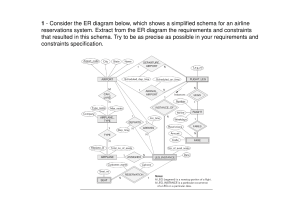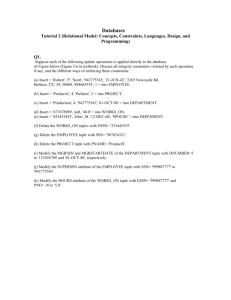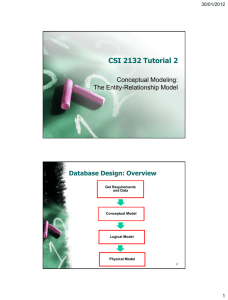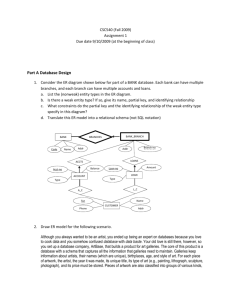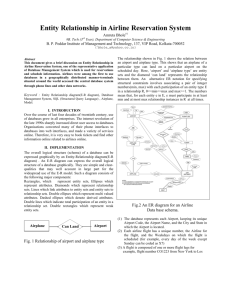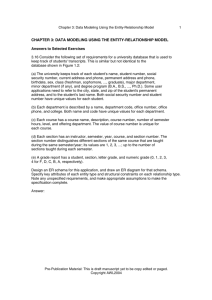Consider the ER diagram below, which shows a simplified schema
advertisement
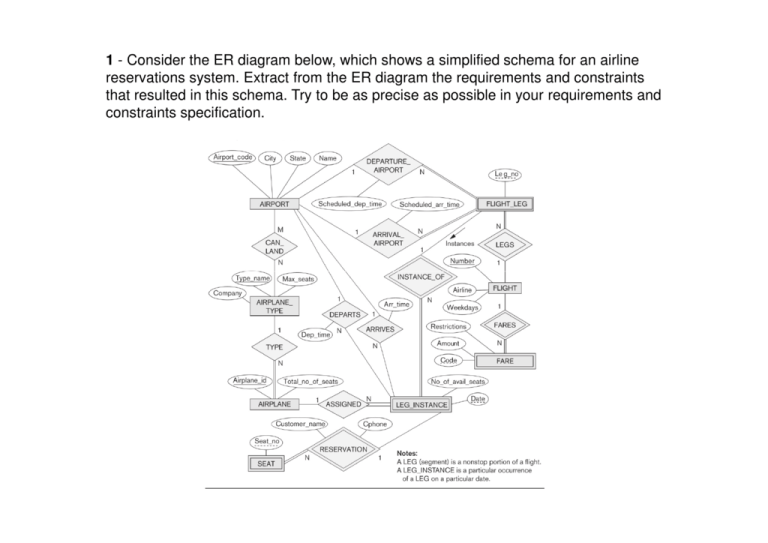
1 - Consider the ER diagram below, which shows a simplified schema for an airline reservations system. Extract from the ER diagram the requirements and constraints that resulted in this schema. Try to be as precise as possible in your requirements and constraints specification. 2 - Cardinality ratios often dictate the detailed design of a database. The cardinality ratio depends on the real-world meaning of the entity types involved and is defined by the specific application. For the binary relationships below, suggest cardinality ratios based on commonsense meaning of the entity types. Clearly state any assumptions you make. Entity 1 Cardinality Ratio Entity 2 1. Student SocialSecurityCard 2. Student Teacher 3. ClassRoom Wall 4. Country CurrentPresident 5. Course TextBook 6. Item (that can be found in an order) Order 7. Student Class 8. Class Instructor 9. Instructor Office 10. E-bay Auction item E-bay bid 3. Consider the ER diagram shown below for part of a BANK database. Each bank can have multiple branches, and each branch can have multiple accounts and loans. (a) List the strong (non-weak) entity types in the ER diagram. (b) Is there a weak entity type? If so, give its name, its partial key, and its identifying relationship. (c) What constraints do the partial key and the identifying relationship of the weak entity type specify in this diagram? (d) List the names of all relationship types, and specify the (min,max) constraint on each participation of an entity type in a relationship type. Justify your choices. (e) List concisely the user requirements that led to this ER schema design. (f) Suppose that every customer must have at least one account but is restricted to at most two loans at a time, and that a bank branch cannot have more than 1000 loans. How does this show up on the (min,max) constraints? 4. Consider the following set of requirements for a UNIVERSITY database that is used to keep track of students' transcripts. (a) The university keeps track of each student's name, student number, social security number, current address and phone, permanent address and phone, birthdate, sex, class (freshman, sophomore, ..., graduate), major department, minor department (if any), and degree program (B.A., B.S., ..., Ph.D.). Some user applications need to refer to the city, state, and zip of the student's permanent address, and to the student's last name. Both social security number and student number have unique values for each student. (b) Each department is described by a name, department code, office number, office phone, and college. Both name and code have unique values for each department. (c) Each course has a course name, description, course number, number of semester hours, level, and offering department. The value of course number is unique for each course. (d) Each section has an instructor, semester, year, course, and section number. The section number distinguishes different sections of the same course that are taught during the same semester/year; its values are 1, 2, 3, ..., up to the number of sections taught during each semester. (e) A grade report has a student, section, letter grade, and numeric grade (0, 1, 2, 3, 4 for F, D, C, B, A, respectively). Design an ER schema for this application, and draw an ER diagram for that schema. Specify key attributes of each entity type and structural constraints on each relationship type. Note any unspecified requirements, and make appropriate assumptions to make the specification complete. 5. Composite and multi-valued attributes can be nested to any number of levels. Suppose we want to design an attribute for a STUDENT entity type to keep track of previous college education. Such an attribute will have one entry for each college previously attended, and this entry is composed of: college name, start and end dates, degree entries (degrees awarded at that college, if any), and transcript entries (courses completed at that college, if any). Each degree entry is formed of degree name and the month and year it was awarded, and each transcript entry is formed of a course name, semester, year, and grade. Design an attribute to hold this information. 6 - Consider the AIRLINE relational database schema shown below, which describes a database for airline flight information. Each FLIGHT is identified by a flight NUMBER, and consists of one or more FLIGHT_LEGs with LEG_NUMBERs 1, 2, 3, etc. Each leg has scheduled arrival and departure times and airports, and has many LEG_INSTANCEs--one for each DATE on which the flight travels. FARES are kept for each flight. For each leg instance, SEAT_RESERVATIONs are kept, as is the AIRPLANE used in the leg, and the actual arrival and departure times and airports. An AIRPLANE is identified by an AIRPLANE_ID, and is of a particular AIRPLANE_TYPE. CAN_LAND relates AIRPLANE_TYPEs to the AIRPORTs in which they can land. An AIRPORT is identified by an AIRPORT_CODE. Consider an update for the AIRLINE database to enter a reservation on a particular flight or flight leg on a given date. (a) Give the operations for this update. (b) What types of constraints would you expect to check? (c) Which of these constraints are key, entity integrity, and referential integrity constraints and which are not? (d) Specify all the referential integrity constraints.
